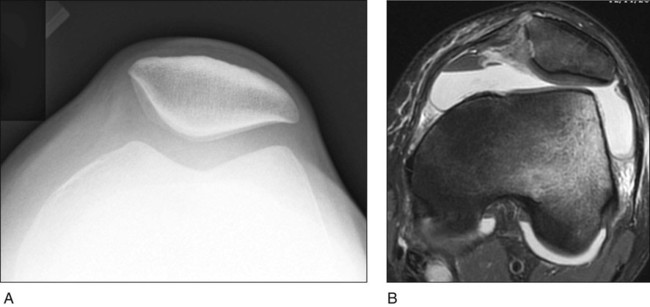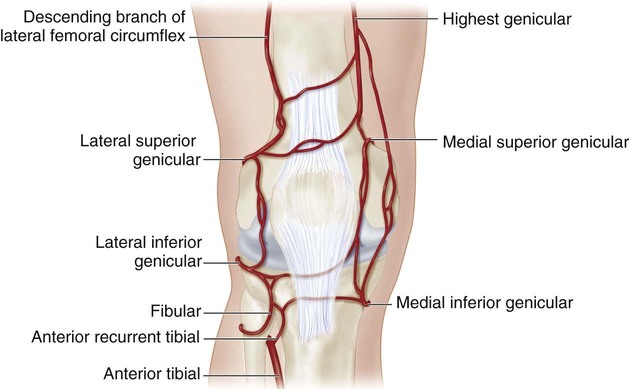• The patella should glide between one and two quadrants medially and laterally. • If the patella glides one quadrant or less medially, the lateral retinaculum is tight. If it glides more than two quadrants medially, the lateral retinaculum is loose.
Patellar Instability
Lateral Release and Medial Plication
Indications
 Lateral release is indicated in patients with patellar tilt and/or a tight lateral retinaculum with patellofemoral pain.
Lateral release is indicated in patients with patellar tilt and/or a tight lateral retinaculum with patellofemoral pain.
 Medial plication can be added if the patient has recurrent patellar subluxations or dislocations or for patellar maltracking following lateral release.
Medial plication can be added if the patient has recurrent patellar subluxations or dislocations or for patellar maltracking following lateral release.
 Medial plication is typically done in conjunction with a lateral release but can be done alone if there is no patellar tilt or tight lateral retinaculum.
Medial plication is typically done in conjunction with a lateral release but can be done alone if there is no patellar tilt or tight lateral retinaculum.
 For patellofemoral pain without instability, extensive nonoperative treatment, including physical therapy for quadriceps strengthening and stretching of the lateral structures, should be done in all patients for at least 6 months prior to surgical treatment.
For patellofemoral pain without instability, extensive nonoperative treatment, including physical therapy for quadriceps strengthening and stretching of the lateral structures, should be done in all patients for at least 6 months prior to surgical treatment.
Examination/Imaging
 A quadrant glide test with the knee in 30° of flexion should be performed to check for lateral tightness.
A quadrant glide test with the knee in 30° of flexion should be performed to check for lateral tightness.
 Standard views as well as sunrise views of both knees should be obtained prior to operating. The sunrise radiograph in Figure 1A reveals lateral tilt of the patella.
Standard views as well as sunrise views of both knees should be obtained prior to operating. The sunrise radiograph in Figure 1A reveals lateral tilt of the patella.

 Magnetic resonance imaging (MRI) can be helpful in determining whether chondral injury is present in the patellofemoral joint. An axial MRI after patellar dislocation (Fig. 1B) shows hemarthrosis, lateral subluxation of the patella, medial retinacular tear, lateral femoral condyle bone bruise, and patellar chondromalacia.
Magnetic resonance imaging (MRI) can be helpful in determining whether chondral injury is present in the patellofemoral joint. An axial MRI after patellar dislocation (Fig. 1B) shows hemarthrosis, lateral subluxation of the patella, medial retinacular tear, lateral femoral condyle bone bruise, and patellar chondromalacia.
Surgical Anatomy
 The superior genicular vessels are near the vastus lateralis musculotendinous junction and must be coagulated thoroughly after lateral release to prevent hemarthrosis.
The superior genicular vessels are near the vastus lateralis musculotendinous junction and must be coagulated thoroughly after lateral release to prevent hemarthrosis.
 Figure 2 shows the arterial supply to the knee. Note where the superolateral genicular artery nears the vastus lateralis.
Figure 2 shows the arterial supply to the knee. Note where the superolateral genicular artery nears the vastus lateralis.

Portals/Exposures
 A standard anterolateral portal should be made next to the patellar tendon and at the level of the inferior pole of the patella.
A standard anterolateral portal should be made next to the patellar tendon and at the level of the inferior pole of the patella.
 An anteromedial portal is made in the standard position.
An anteromedial portal is made in the standard position.
 Medial plication requires a 4-cm incision placed 1 cm medial to the medial border of the patella.
Medial plication requires a 4-cm incision placed 1 cm medial to the medial border of the patella.
 Figure 3 shows the standard positions for arthroscopic portals, and the potential incision for a medial plication is marked.
Figure 3 shows the standard positions for arthroscopic portals, and the potential incision for a medial plication is marked.

Procedure: Arthroscopic Lateral Release
Step 1
 The anterolateral portal is made first, and a standard diagnostic arthroscopy proceeds. Patellar tilt and tracking should be observed in relation to the trochlear groove.
The anterolateral portal is made first, and a standard diagnostic arthroscopy proceeds. Patellar tilt and tracking should be observed in relation to the trochlear groove.
 The lateral release can be performed with either electrocautery or Metzenbaum scissors.
The lateral release can be performed with either electrocautery or Metzenbaum scissors.
 The lateral release should be performed from the level of the anterolateral arthroscopic portal to the musculotendinous junction of the vastus lateralis, aiming approximately 20° lateral to the patella while heading proximally.
The lateral release should be performed from the level of the anterolateral arthroscopic portal to the musculotendinous junction of the vastus lateralis, aiming approximately 20° lateral to the patella while heading proximally.![]()
Stay updated, free articles. Join our Telegram channel

Full access? Get Clinical Tree


Musculoskeletal Key
Fastest Musculoskeletal Insight Engine



